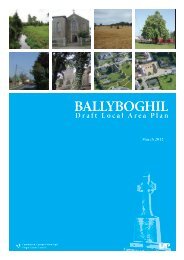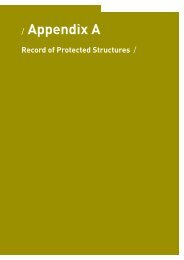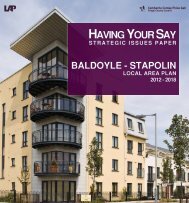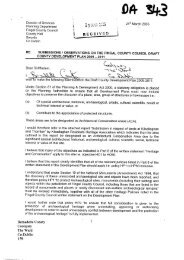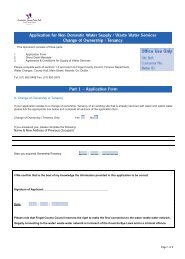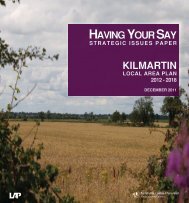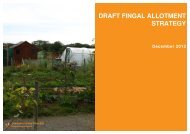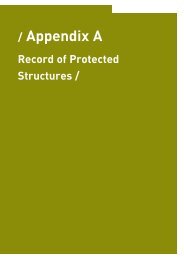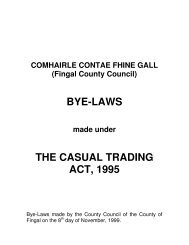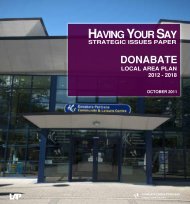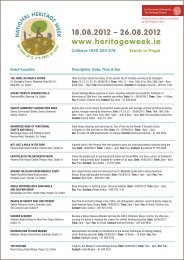Donabate Urban Centre Strategy Fingal County Council
Donabate Urban Centre Strategy Fingal County Council
Donabate Urban Centre Strategy Fingal County Council
Create successful ePaper yourself
Turn your PDF publications into a flip-book with our unique Google optimized e-Paper software.
8.0 Traffic Management Plan and Car Parking <strong>Strategy</strong><br />
8.8 Signal control<br />
A crossing point exists in the town centre adjacent to the Catholic<br />
Church and local retail centre. In this study, two further potential<br />
crossing points have been identified in the town centre: to the north at<br />
the junction with Beaverstown Road and to the south at the junction<br />
with Balcarrick Road.<br />
The provision of signalised junctions in these locations could provide<br />
strong “gateway” features at either main approach to the town. Traffic<br />
signals are also a positive traffic control measure, giving safe crossing<br />
opportunities to pedestrians and especially vulnerable road users.<br />
Crossing points should be a minimum of 2.4m wide, however up to<br />
5m is recommended by the Traffic Management Guidelines where<br />
conditions are appropriate.<br />
Various signal layout options may be considered. For example, to<br />
the north of the town an all-round pedestrian crossing point may be<br />
considered, which would provide improved pedestrian access to local<br />
schools. In the town centre a widened (up to 5m) crossing point may<br />
be considered. To the south of the town the signal layout would need<br />
to be integrated with proposed bus stop layout revisions which can<br />
include staggered bus stops, bus boarders and a pedestrian link to the<br />
rail station. The detailed design and location of all signals needs to be<br />
finalised.<br />
Example of a wide pedestrian crossing point<br />
8.9 Traffic restrictions<br />
Traffic speed restrictions can be a positive instrument towards the<br />
creation of a “main street” environment and promoting safer routes to<br />
schools and should be incorporated with strong environment measures<br />
where appropriate.<br />
Weight restrictions are often applied throughout town centres. While<br />
these may be a consideration in <strong>Donabate</strong>, currently volumes of HGVs<br />
are low and some commercial access is likely to be required for<br />
increased town centre activities.<br />
It is recommended that a 30kmph zone (subject to approval) be<br />
implemented from Hearse Road / Turvey Road (west of the rail<br />
crossing) to the junction of Main Street with the Portrane Road and<br />
continued past school entrances near the town.<br />
8.10 Bus / Rail Hub<br />
Currently <strong>Donabate</strong> town centre is served by the 33B Dublin Bus<br />
service. There are 9 inbound services between 06.00 and 10.00 daily.<br />
The service terminates at Swords where a QBC service operates<br />
to Dublin city centre. A number of bus stops are located along the<br />
Portrane Road, Main Street and Turvey Road.<br />
The forecasted growth in population and existing latent demand for<br />
public transport suggests that the level of bus service to and from<br />
<strong>Donabate</strong> can significantly increase. DTO travel survey data suggests<br />
that there are a large amount of trips to the north city areas unserviced<br />
by public transport. There will also likely be demand for a local bus<br />
service between the town centre and new residential areas provided<br />
for in the LAP.<br />
The LAP requires that quality shuttle services be in place to serve<br />
the planned Metro and existing Swords QBC. However, in reality, a<br />
service to the Swords QBC is already provided from Portrane serving<br />
<strong>Donabate</strong>. It is likely that bus services will likely have to be increased<br />
in the future.<br />
In the future development of the lands around the rail station (Area 4<br />
within the <strong>Donabate</strong> LAP 2006) provision is required for a transport<br />
interchange with additional commuter parking in the form of a multistorey<br />
facility, bus parking and turning facilities as well as pedestrian and<br />
cycle facilities. Two recommended options to be considered for the<br />
short-term and long-term are described as follows:<br />
SHORT-TERM OPTION<br />
Strengthen facilities on existing corridor:<br />
Given the current low level of existing services (maximum 4 per hour)<br />
the existing main street corridor is likely to be able to accommodate<br />
forecasted increases in services. A safe and direct pedestrian connection<br />
should be provided to the station. Bus facilities, including bus boarders,<br />
“Kassel” kerbs and “Landmark” shelters should be considered as<br />
part of an improved main street layout. A staggered bus stop layout<br />
incorporating a signal-controlled pedestrian crossing is recommended.<br />
This would afford an improved public realm, better bus priority and<br />
minimisation of delays to bus services. Please refer to page 35.<br />
LONG-TERM OPTION<br />
All northbound and southbound services interchange within<br />
station area:<br />
This may be achieved by the creation of a loop for southbound services<br />
or a right-turn entry exit system as well as a bus stop for services<br />
travelling north to Portrane from Swords and south to Swords from<br />
Portrane. This option would require additional traffic management to<br />
accommodate right-turning buses. Please refer to page 36.<br />
Of both options, the short-term affords the best bus priority, least<br />
disruption of services, contributes to an improved public realm and<br />
facilitates a strong connection with the rail station. Retaining strong<br />
<strong>Donabate</strong> <strong>Urban</strong> <strong>Centre</strong> <strong>Strategy</strong> 31




